This has been – is being – a rough week, so this post is designed to be undemanding and easy on the eye. Continuing with the theme of patterns in nature, this week I feature spots and dots, shapes from nature that are appreciated and celebrated. Such patterns are re-presented in many forms, such as in leopard skin prints and polka-dot fabrics, but here I stick with dots I spotted in their natural form.
Spotted cats are perhaps the most famous representatives of dot patterns in nature. The cheetah (Acinonyx jubatus) in the photo above is a beautiful example.
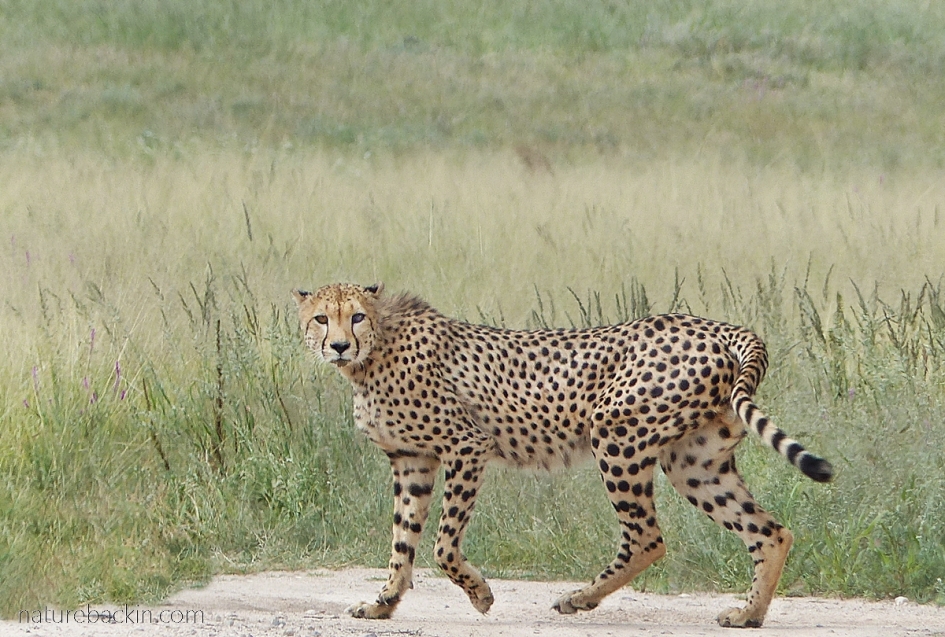
Here is another photo of the same cheetah when he came out into more open ground near the road (photographed at Mabuasehube Game Reserve, part of the Kgalagadi Transfrontier Park in Botswana). Just look at those long and strong hind legs that can power him into incredibly fast action when he needs to give chase.
It is thought that spots help break up the shape of an animal and provide a form of camouflage, which can benefit predators such as cats, and also prey – think for example of spots dappling the fur of baby deer fawns. As they grow older they shed their spots as they moult into their adult coloration.

We don’t have deer occurring naturally in South Africa, only antelope, such as bushbuck (Tragelaphus sylvaticus). Bushbucks vary a lot in their colour and also in the number of stripes and spots that they carry, with some variations being characteristic of specific regional populations. The bushbuck in the photo above has only a few spots on its flanks, and no vertical stripes. I photographed this bushbuck as he crossed a road while I was walking near the campsite at Cape Vidal near St Lucia in the iSimangaliso Wetland Park World Heritage Site in KwaZulu-Natal.

Leopards (Panthera pardus) must surely be the king of spotted cats. We almost failed to notice this leopard sitting in dense vegetation not far from the road in Mabuasehube Game Reserve. I took this photo from the car window before the leopard moved off and it silently and swiftly melted into the foliage.
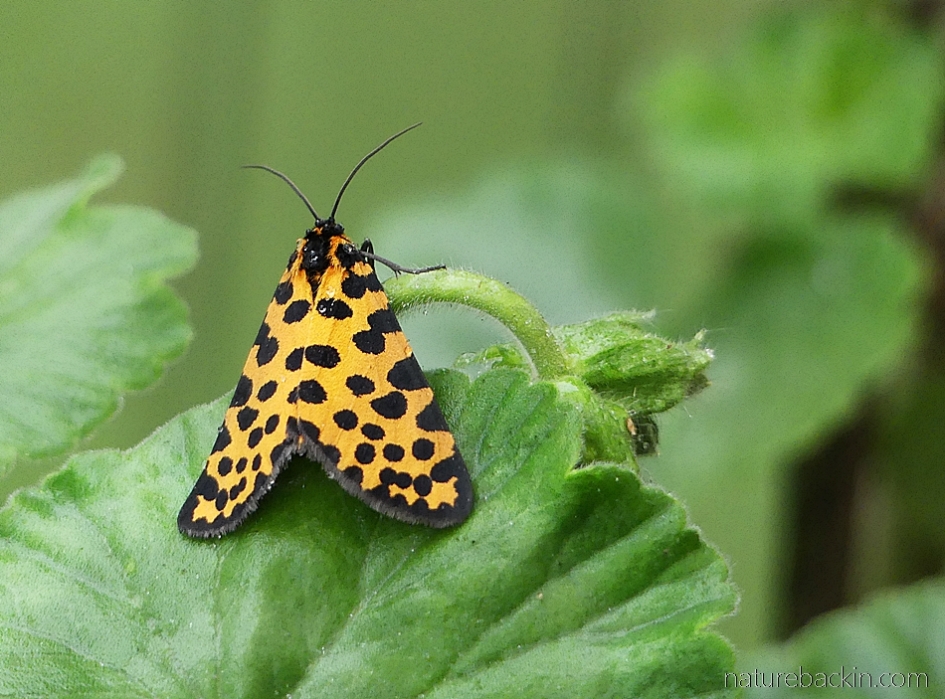
Taking its common name from the big spotted cat, this leopard magpie moth (Zerenopsis lepida) is striking in both its colour and spottedness. It was resting at dusk earlier this week on a potted pelargonium on our front deck.
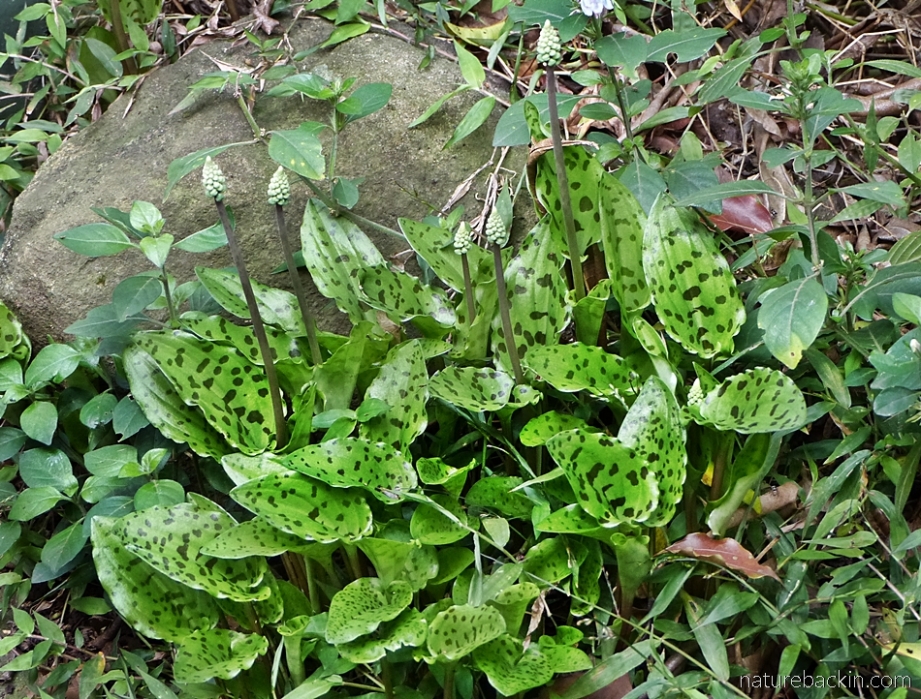
Also named for the big spotted cat, this leopard lily (Ledebouria petiolata – previously known as Drimiopsis maculate) sports spots on its leaves. We can only speculate what practical purpose these spots might serve.
I can think of only a few plants with spotted leaves and they don’t occur in our garden. We used to have arum lilies (calla lilies – Zantedeschia aethiopica) with spotted leaves in the garden, but I have grown the next generation from seed and they have reverted to having leaves of a solid green colour.
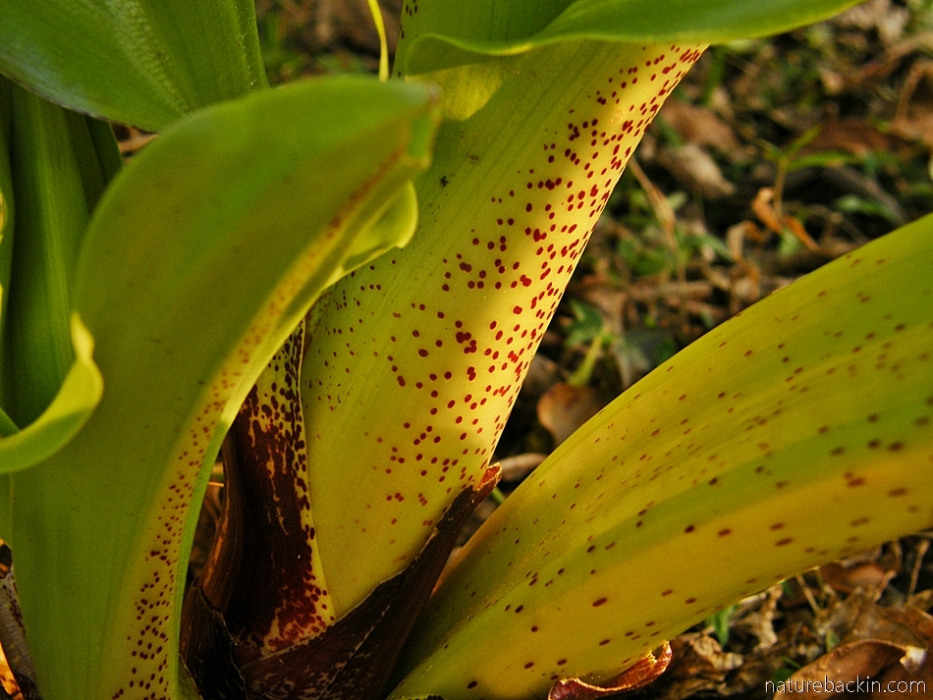
The snake lily also known as the paintbrush lily (Scadoxus puniceus) bears spots at the base of young flower stalks in the spring.

Fern spores group into spot-shaped clusters on the underside of the leaf of a fern. For information on the complex life cycle of ferns and how they reproduce see here.

We do not have any obviously spotted flowers in our garden – so I stretched the pattern a bit to show the dots, dashes, splashes and stripes on the flowers of the ribbon bush (Hypoestes aristata).

There are small dots and three dark almost spot-like patches on the flowers of the yellow wild iris (Dietes bicolor) that grows in our garden.
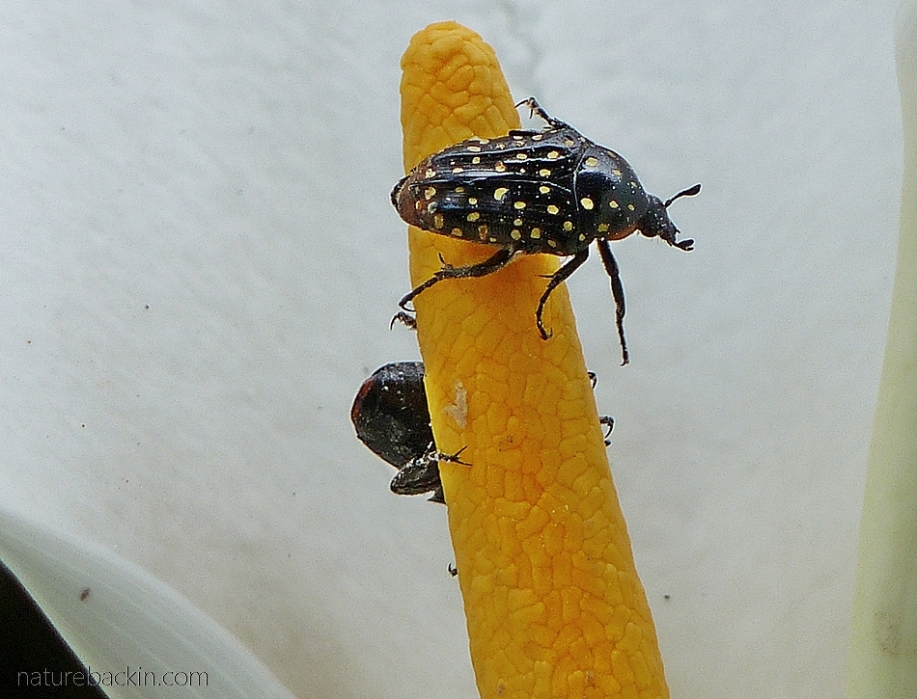
It appears that more insects are likely to bear spots and dots than flowers. In the above photo, common-dotted fruit chafers (Cyrtothyrea marginalis) are feeding on nectar from the miniscule yellow male flowers on the spadix of an arum (calla) lily (Zantedeschia aethiopica). The female flowers are usually unseen as they are concealed where they form at the base of the spadix. The spadix is surrounded by a protective white spathe, which is commonly thought of as the flower of the arum.
Fruit chafers eat nectar and I have not found any eating the spathes of arum lily. I always leave the chafers to do their nectar-eating and pollinating thing with no apparent damage to the arums. In fact our arums produce a lot of seed – perhaps because of these visiting pollinators – and I collect the seed to generate new plants.

Ladybirds, or more accurately ladybeetles, are well known for their spots although not all species of ladybirds do in fact bear spots. Spotted or not their conspicuous colour serves as a warning to predators that they are toxic to eat. The only indigenous ladybirds I have photographed in our garden do not have spots, so we will have to make do with this spotted example, which unfortunately is an alien harlequin ladybird (Harmonia axyridis).

The brown commodore butterfly (Junonia natalica natalica) displays prominent spots some of which resemble eye-spots that may serve to deceive predators. The formation of patterns, including eye-spots, has been the subject of much scientific study.
Looking for an undemanding pattern to be the focus of this post, I thought spots might mean that mathematics would not come into the picture. I soon learnt that this assumption was wrong. In fact the formation of patterns and shapes in nature and their regulation, a process known as morphogenesis (literally the formation of a body’s shape), was the subject of a study by Alan Turing, who was a mathematician involved also in other academic disciplines and theoretical and practical fields of study. Perhaps he is best known for his code-breaking work at Bletchley Park in Britain during World War II and for his pioneering work as a computer scientist.
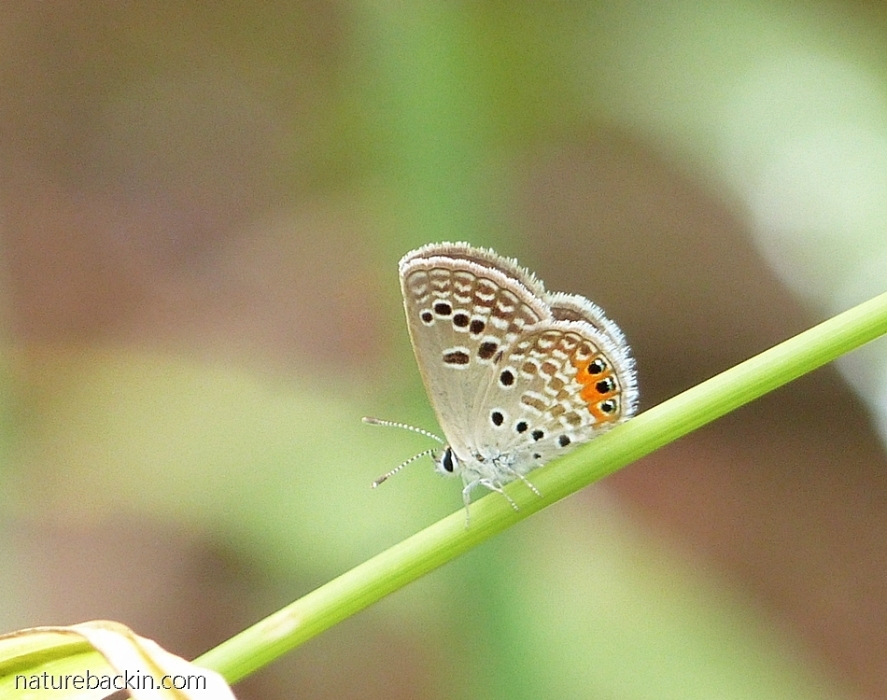
The small grass jewel butterfly (Freyeria trochylus – formerly Chilades trochylus) has an exquisite pattern that abounds with dots
Turing was also interested in mathematical biology, and in a 1952 paper “The Chemical Basis of Morphogenesis” he presents a mathematical model to explain the production and self-regulation of pattern morphogenesis in plants and animals.
The process of developing pattern formations involves two chemicals that react with each other as they diffuse through the body at a cellular level. These reaction-diffusion mechanisms Turing mapped mathematically. Only recently has computer modelling been able to demonstrate that Turing’s mathematical models can accurately predict pattern formation during development in certain species, for example in species of striped fish.
Well this very brief introduction is all I can manage for now, so I only add that further work is being done utilizing Turing’s models in investigating the development of patterning in animals, including in the hair of mammals and in feathers of bird – for more information see, for example, here.

The occurrence of spotted patterns in birds is relatively common, such as in the lovely spots on the plumage of an African olive (formerly Rameron) pigeon (Columba arquatrix), this bird photographed in our garden. Sometimes though the appearance of spots can result from how barring is revealed by overlapping feathers.
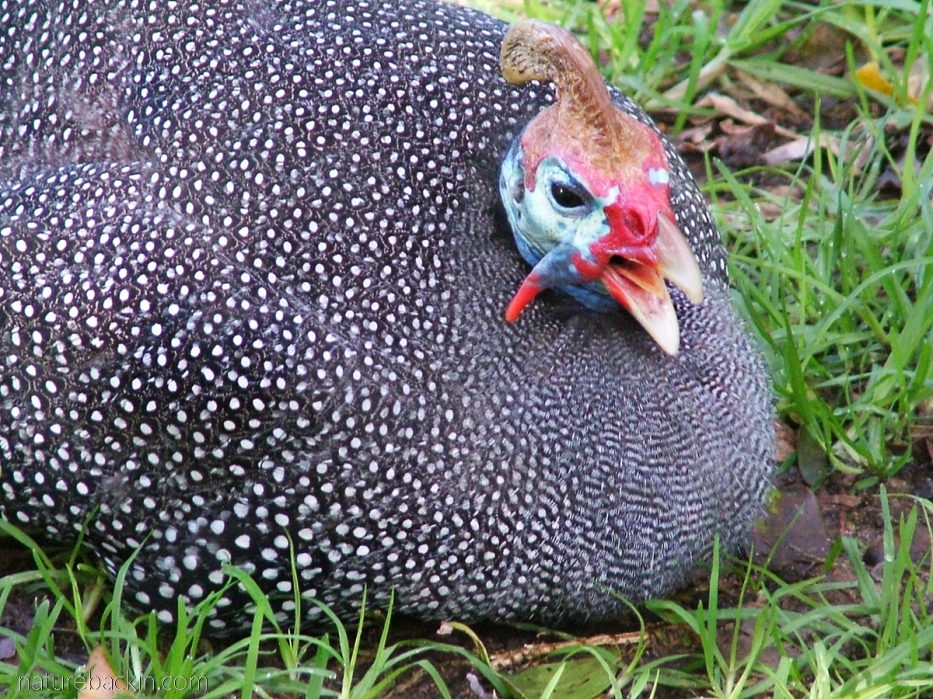
One of the best known of our spotted bird is the helmeted guineafowl (Numida meleagris). This one I photographed while it was resting on the grass at Kirstenbosch National Botanical Garden in Cape Town.
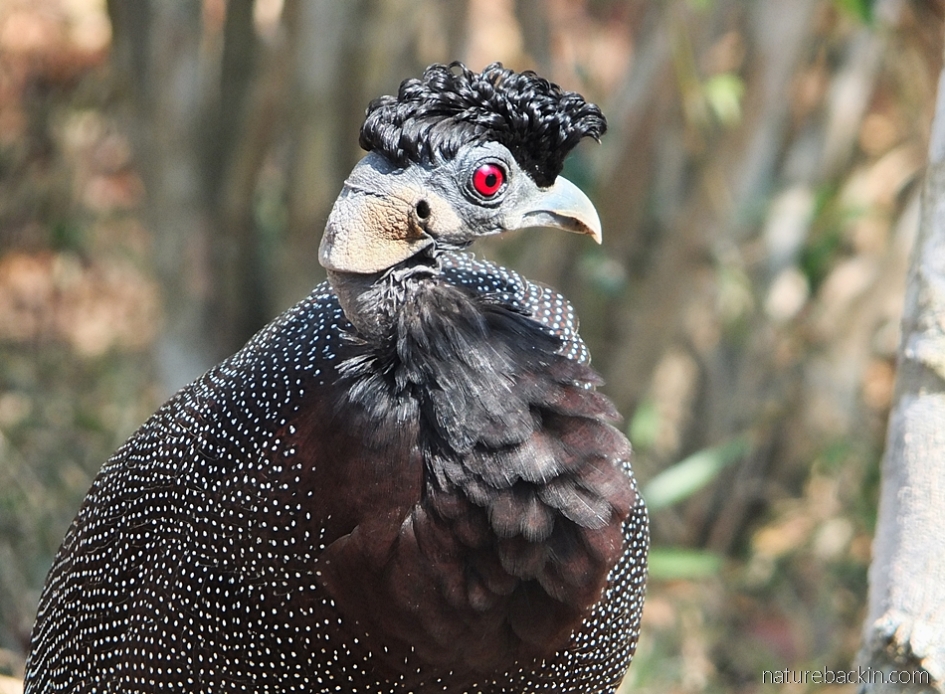
With a wig-like feathered ‘hairdo’, vivid scarlet eyes, and a kind of feathered jabot, the crested guineafowl (Guttera pucherani) also has spotted feathers on its body. I photographed the above crested guineafowl while we were walking at Kuleni Game Reserve, near Hluhluwe in KwaZulu-Natal.

The beautiful pattern formed by the markings on the feathers of a Burchell’s sandgrouse (Pterocles burchelli) is enlivened by white spots. A bird of the Kalahari Desert sands, this sandgrouse I photographed early one morning in the Central Kalahari Game Reserve in Botswana.

I find it somehow unexpected that the largest of our eagles, the African martial eagle (Polemaetus bellicosus), is decorated with spots. This eagle at Mkhuze Game Reserve in KwaZulu-Natal is ruffling its feathers and looking uncharacteristically frilly, in a photo that is somewhat grainy because it was taken at quite a distance.

And so I end this selection of spotted creatures and plants with a spotted hyena (Crocuta crocuta), a species that along with cats falls into the suborder Feliformia. I always find the intensity displayed by hyenas undeniable. This individual is making its way probably back to its den early one morning at the Addo Elephant National Park in the Eastern Cape.
The order Carnivora is divided into two suborders: Feliformia and Caniformia. Included in Felimormia, along with cats and hyenas are mongooses, genets, Malagasy carnivores, civets and Asiatic linsangs (I had to look them up). Included in the suborder Caniformia are dogs, bears, red panda, skunks, members of the Mustelidae family (ferrets, weasels, badgers, otters and so on), racoons, walruses and seals. I wonder how many species in these two suborders of Carnivora are spotted?
Sources: Chen, Jessica W. 2012. Understanding Pattern Formation during Morphogenesis. Harvard University. The Graduate School of Arts and Sciences. http://sitn.hms.harvard.edu/flash/2012/morphogenesis/; Untamed Science. [n.d.] Order Carnivora: The Carnivores. https://untamedscience.com/order/carnivora/
Posted by Carol









November 15, 2020 at 7:17 am
This is quite a brilliant post. A very intriguing series of posts too. I’ll slowly read through all of them 😀
LikeLiked by 2 people
November 15, 2020 at 11:57 am
Thanks very much Saurab. While compiling these posts I am looking at nature in quite different ways!
LikeLiked by 1 person
November 11, 2020 at 6:38 pm
I did not know there was so much wildlife with spots and dots! Great post and very thought provoking since I found out the names of new species.
LikeLiked by 2 people
November 13, 2020 at 8:42 pm
Thanks and I am happy to introduce some new species.
LikeLike
November 10, 2020 at 12:01 am
What fabulous detail both in image and word. It’s always a pleasure to dive into your posts because they always offer so much. I tend to put aside reading it because it requires shutting out other distractions. That certainly hasn’t been easy these past weeks/months here.
Thanks for taking me along on this spot-on adventure! 😀
LikeLiked by 2 people
November 10, 2020 at 8:36 pm
Thanks for taking the time to read this post Gunta. There are plenty of worrisome distractions abounding, unfortunately.
Spots made for a welcome diversion 😊
LikeLike
November 8, 2020 at 6:59 am
I thoroughly enjoyed reading your post. All your photos are stunning, in particular the one of the leopard, which shows clearly just how the colouring of his body can blend so naturally in with the vegetation. I forgot just how almost hypnotising the markings on the flowers of the Hypoestes are. I knew a German lady who battled to say the word Hypoestes and instead called them ‘happy easters’, something I have never forgotten! I found the information on the pollination of the arums by the chafers very interesting. I used to have arums in the garden but as far as I can remember none produced any seed. The martial eagle is a magnificent bird, even with his spotted bloomers! Math’s is not my forte but I still found it a fascinating read about the modelling. Thank you for a lovely post.
LikeLiked by 2 people
November 10, 2020 at 8:16 pm
Thanks very much. I think I might adopt the name ‘happy easters’ too for Hypoestes 😊
The arum is an interesting plant and it is nice when it produces its own seed and also that it germinates quite successfully. However, transplanted seedlings need a bit of coddling at first.
The fluffed out spotty feathers of the martial eagle are rather bloomer like!
Maths is not my forte either and it is surprising how interesting the maths related to patterns in nature seems to be even though it is hard work to try to understand it even most superficially!
LikeLiked by 1 person
November 14, 2020 at 10:55 am
Ha ha! Be prepared for some funny looks from people when you say happy easters!!
LikeLiked by 1 person
November 14, 2020 at 3:24 pm
😊
LikeLike
November 7, 2020 at 8:54 pm
Marevelous, Carol, the Martial eagle,especially.
Hope the week finishes on a plus for you.
LikeLiked by 2 people
November 9, 2020 at 9:24 pm
Thanks very much Ark. The week has been a mixed bag. We are now experiencing heavy rain after very intense heat. One extreme to the next it seems. I think it is similar in Jhb?
LikeLike
November 10, 2020 at 9:50 am
Indeed. Raining cats and dogs as it does this time of year.
Everything seems to green almost overnight and the vegetable garden goes bonkers!
LikeLiked by 1 person
November 7, 2020 at 9:13 am
It’s very interesting and a wonderful collection of pictures! The Polemaetus bellicosus is such a beautiful bird!
LikeLiked by 2 people
November 9, 2020 at 9:18 pm
Thanks Simone. Yes, it is an especially beautiful eagle.
LikeLiked by 1 person
November 6, 2020 at 9:32 pm
i find all this very interesting, but also the fact, what i have always called ladybugs, you call them ladybirds.
LikeLiked by 2 people
November 9, 2020 at 8:52 pm
Thanks Buddy – I think ladybird is the UK naming convention that we follow here, for what we should all more accurately call ladybeetles! 🙂
LikeLike
November 9, 2020 at 8:59 pm
👍👍👍👍😷😷🙂🙂🙂
LikeLiked by 1 person
November 6, 2020 at 3:26 pm
Wonderful post. Thank so much!
LikeLiked by 2 people
November 6, 2020 at 8:42 pm
Thanks very much Isabel.
LikeLike
November 6, 2020 at 3:17 pm
What a lovely post and full of interesting thoughts. Spotted coats are common in felids (servals, lynx, jaguars and many small cat species come to mind) but unheard of in canids outside of domestic dog breeds. You get mottled ones, like African wild dogs, but none that are truly spotted. I wonder if that’s driven by their different hunting strategies? Cats value camouflage; a coursing predator has much less reason to need it. That said, I was having a conversation with someone recently about ‘countershading’ in foxes, i.e. pale underneath and darker on top, which helps break up their outlines. An article I read pointed out that animals that don’t need to fear anything e.g. – skunks – have the exact opposite pattern.
I didn’t know that harlequin ladybirds were a problem in your area. They’ve invaded the UK too.
LikeLiked by 2 people
November 6, 2020 at 8:42 pm
How interesting that wild canids do not have spots. Of course they have other forms of camouflage that enable them to blend in with their environment – the Artic fox is a rather dramatic example. And as you point out, the countershading in foxes too – and even that slight grizzle to their coats. I suppose also whether they are nocturnal or not also plays a role in their colouration. I suppose that as much as they need to conceal themselves from prey, they also need to conceal themselves from other predators to avoid being prey themselves! It is interesting too that colouration can have different effects depending on proximity. It seems that the colouration of skunks can serve as warning.
Too bad that harlequin ladybirds are a problem in so many places. I read that harlequin ladybirds were first observed in the Western Cape in the early 2000s and they have since spread across much of the country. They out-compete native species and have been shown to be more resilient/adaptable in the face of rising temperatures due to climate change. There are South African research projects on the go on ways to control them …
LikeLike
November 6, 2020 at 7:52 am
Oooooooooooooo What a wonderful post. Another set of spell-binding photographs and dense information. A visual and cerebral feast. Thank you Carol
LikeLiked by 2 people
November 6, 2020 at 8:15 pm
Thanks Mariss – when I had the idea to look for spots and dots I had no idea where it might lead so it was quite interesting seeing where it went using photos I have in my archive.
LikeLike
November 7, 2020 at 12:40 pm
Your archive of photographs is a treasure trove. I am sure you must have a good filing system so that you can find them easily. Or maybe you just remember dates and shots
LikeLiked by 1 person
November 9, 2020 at 9:23 pm
I do have a system for classifying photos but that system does not take into account spots or not 🙂
LikeLiked by 1 person
November 8, 2020 at 1:07 pm
What a fascinating post, Carol, and the photography is superb!
LikeLiked by 1 person
November 9, 2020 at 9:27 pm
Thanks very much Christine.
LikeLike
November 6, 2020 at 4:06 am
It has been/is being a rough week for many people around the world. I hope yours picks up soon. So many details you’ve spotted (sorry, couldn’t help myself) in your neck of the woods. I love the guineafowl, which looks like a 1950’s rocker, and the eagle is quite splendid. Also, fascinating to learn about Turing’s work, which I’d never heard of before. It’s a bit disturbing how much of life can be broken down into mathematical models. Rather takes the mystery out of it.
LikeLiked by 2 people
November 6, 2020 at 8:12 pm
Absolutely that has been a rough week for many …
You are so right likening the guineafowl to the 50s rockers 🙂
That work by Turing is very interesting although complex and hard to get even a rudimentary a grip on, for me at least. I gather though that his models have their limitations – so there is still plenty of mystery out there!
LikeLiked by 1 person
November 6, 2020 at 2:55 am
You never disappoint! I have thoroughly enjoyed this journey into the dazzling world of spots and dots and particularly the extra adventure into flowers, insects and birds.
LikeLiked by 2 people
November 6, 2020 at 8:04 pm
Thank you Anne – you are right the world of spots and dots can be dazzling 🙂
LikeLike
November 6, 2020 at 2:30 am
What a glorious celebration of natural spots and dots, Carol!
Hope your week starts to turn for the better today.
LikeLiked by 2 people
November 6, 2020 at 8:03 pm
Thanks – I am finding that looking for patterns has the potential to become addictive. Thanks also for the good wishes – I hope too that you have a lovely weekend.
LikeLiked by 1 person
November 6, 2020 at 2:21 am
Looking at the photos of leopard, insect, butterfly, and bird is hypnotizing. I understand the camouflage; the leopard in the dense foliage makes that clear. I wonder if the spots are in any way hypnotizing and thereby distracting to predators, but I imagine once they “spot” their prey, they do not allow its spots to divert their aim.
The plants, on the other hand, are a puzzle. In this moment, I like to think that they are designed as such to protect the little bugs who seek their shelter. The insects blend in with the spotty leaves and safely escape detection. As I said, I just like to think that.
Thank you for the treat.
LikeLiked by 2 people
November 6, 2020 at 8:01 pm
It is interesting to think about complex interactions between predators and prey. And the relationship between plants and insects is also fascinating as they are so codependent. And how nice that we appreciate flowers as much as insects do!
LikeLiked by 1 person
November 6, 2020 at 2:00 am
Indeed easy on the eye and heart, thank you Carol for your beautiful insights into spots and dots in the natural world! xxx
LikeLiked by 2 people
November 6, 2020 at 7:49 pm
Thanks Christeen – I did enjoy spotting the dots 🙂
LikeLiked by 1 person
November 6, 2020 at 12:54 am
Fascinating post, Carol, informative with excellent photos. I wonder what it is in our own brains that makes spots so attractive? I love polka dots!
LikeLiked by 1 person
November 5, 2020 at 9:48 pm
Ah, always a treat – to the eye as well as to the urge for information and knowledge. You are indeed a source of joy and love for the natural world! I was truly mezmerized by the African martial eagle – never seen one before.
LikeLiked by 2 people
November 6, 2020 at 7:48 pm
Thanks for your kind comment Leya. The martial eagle is a particularly spectacular eagle.
LikeLiked by 1 person
November 5, 2020 at 9:47 pm
Amazing, as always. Especially love that guineafowl
LikeLiked by 2 people
November 6, 2020 at 7:46 pm
Thanks very much M.B. Guineafowls can be as eccentric in their behaviour as they are in their looks 🙂
LikeLiked by 1 person
November 5, 2020 at 9:26 pm
A wonderful collection, Carol…as always!
LikeLiked by 2 people
November 6, 2020 at 7:44 pm
Thanks so much Sandy.
LikeLiked by 1 person
November 7, 2020 at 12:34 am
My pleasure.
LikeLiked by 1 person
November 5, 2020 at 9:25 pm
Well, this is as ever informative as well as a visual treat. Perhaps I’ll go and read it to the group of ladybirds who appear to have decided to over-winter at the top of the bedroom window frame.
LikeLiked by 2 people
November 6, 2020 at 7:43 pm
Thanks Margaret. I have never seen ladybirds congregating like that here, perhaps the winters are not cold enough.
LikeLike
November 6, 2020 at 9:44 pm
Yup. Huddling may help.
LikeLiked by 1 person
November 9, 2020 at 8:53 pm
That too and being indoors!
LikeLike